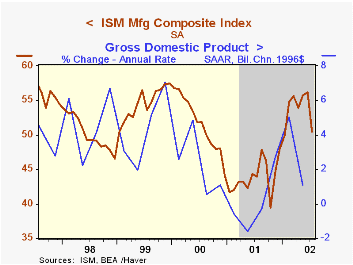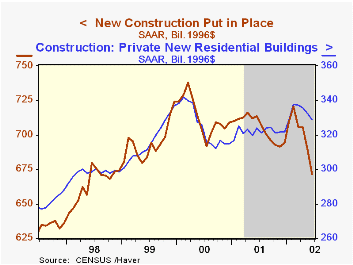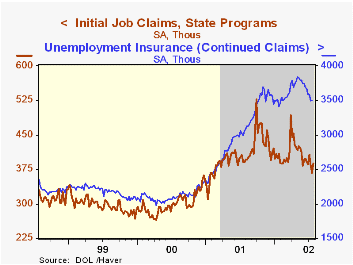 Global| Aug 01 2002
Global| Aug 01 2002ISM Index Down Sharply in July
by:Tom Moeller
|in:Economy in Brief
Summary
The ISM Composite Index of manufacturing sector activity was much weaker than expected last month, falling to the lowest level since January. Consensus expectations were for a decline to 55.0. Each of the component series declined, [...]

The ISM Composite Index of manufacturing sector activity was much weaker than expected last month, falling to the lowest level since January. Consensus expectations were for a decline to 55.0.
Each of the component series declined, but orders and production were notably lower.
Inflation pressure rose sharply as the percentage of companies reporting lower prices fell even further. The percentage of companies reporting higher prices rose slightly.
Over the last twenty years there has been a 68% correlation between the ISM Composite Index and the quarterly growth in chained GDP.
| ISM Manufacturing Survey | July | June | Y/Y | 2001 | 2000 | 1999 |
|---|---|---|---|---|---|---|
| Composite Index | 50.5 | 56.2 | 43.9 | 43.9 | 51.6 | 54.6 |
| Prices Paid Index | 68.3 | 65.5 | 39.9 | 43.0 | 64.8 | 54.2 |
by Tom Moeller August 1, 2002

The value of construction put in place was weaker than expected in June. A slight gain had been expected. May's figures were lowered sharply due to weaker activity in the nonresidential sector.
Residential building fell for the third consecutive month. Single family building has been flat of late but multi-family has fallen in four of the last six months.
Nonresidential building activity fell sharply for the fourth month this year. Nonresidential building activity peaked in March 2001 and has since fallen 24.0%. Industrial and office building ticked higher last month after several months of sharp decline.
Spending by governments fell for the third month this year led by lower building in the industrial and hospital areas.
| Construction Put-in-place | June | May | Y/Y | 2001 | 2000 | 1999 |
|---|---|---|---|---|---|---|
| Total | -2.2% | -2.0% | -3.7% | 2.5% | 7.3% | 8.7% |
| Residential | -0.9% | -0.9% | 3.9% | 3.3% | 7.4% | 11.2% |
| Nonresidential | -3.4% | -4.9% | -20.1% | -3.1% | 7.1% | 1.9% |
| Public | -3.1% | 2.1% | 1.8% | 7.4% | 5.4% | 10.6% |
by Tom Moeller August 1, 2002

Initial claims for unemployment insurance rose slightly more than expected in the latest week. The prior week's level was revised up slightly.
Continuing claims for unemployment insurance rose 0.1% for the first rise in six weeks, but the prior week's level was revised down.
The four-week moving average of initial claims rose slightly to 386,000, -2.8% y/y.
The insured rate of unemployment was unchanged at 2.7%.
| Unemployment Insurance (000s) | 7/27/02 | 7/20/02 | Y/Y | 2001 | 2000 | 1999 |
|---|---|---|---|---|---|---|
| Initial Claims | 387.0 | 367.0 | -1.0% | 405.8 | 299.8 | 297.7 |
| Continuing Claims | -- | 3,502 | 17.2% | 3,021 | 2,114 | 2,186 |
Tom Moeller
AuthorMore in Author Profile »Prior to joining Haver Analytics in 2000, Mr. Moeller worked as the Economist at Chancellor Capital Management from 1985 to 1999. There, he developed comprehensive economic forecasts and interpreted economic data for equity and fixed income portfolio managers. Also at Chancellor, Mr. Moeller worked as an equity analyst and was responsible for researching and rating companies in the economically sensitive automobile and housing industries for investment in Chancellor’s equity portfolio. Prior to joining Chancellor, Mr. Moeller was an Economist at Citibank from 1979 to 1984. He also analyzed pricing behavior in the metals industry for the Council on Wage and Price Stability in Washington, D.C. In 1999, Mr. Moeller received the award for most accurate forecast from the Forecasters' Club of New York. From 1990 to 1992 he was President of the New York Association for Business Economists. Mr. Moeller earned an M.B.A. in Finance from Fordham University, where he graduated in 1987. He holds a Bachelor of Arts in Economics from George Washington University.






